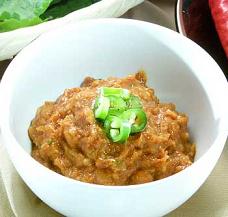
The Institute of Royal Korean Cuisine at Changdeokgung Palace
Those of us who grew up in Korean homes have a good idea of homestyle Korean cooking and often other forms like restaurant fare and street food. But what constitutes authentic Korean cuisine? Discerning what is authentic from what is common may be challenging if we have not been exposed to the traditional forms of Korean food. That is not to say that food cannot be authentic if it is not traditional. According to Seoul Eats, the modern form of patbingsu emerged "after the Korean War and during the US occupation" using the "surplus supplies" from the U.S. army base (except for the red beans).
Being exposed to dishes in all their variations helps one determine the common approach to preparing a dish, but it is also important to study the history of Korean cuisine to understand what is truly authentic. Dishes emerge from a certain time and place and the spirit of the people and culture that inhabited that period of history. Modern Korean cuisine is greatly influenced by the culinary traditions of its past, but is a different creation in itself. The use of industrialized ingredients like commercial soy sauce, daenjang (된장, soy bean paste), and gochujang (고추장, red pepper paste) make it more convenient for modern day Koreans to prepare their own food. Of course, there are Koreans that make their own soy sauce and pastes, but preparing Korean food today is a much different endeavor from before the industrial age with the mass production of these essential ingredients. Food, like other products of culture, evolves with the times and the changing mentality of the people.

Dwaenjang or 된장 via Trifood
Kochujang or 고추장 via Trifood
So what makes a food authentically Korean if the culture that creates it constantly changes? In order to determine that, one needs to look at the time and place from which a food originates as well as its ingredients and method of preparation. In order for a food to be authentic to a specific place, it needs to originate from there. There needs to be confirmation that the dish originated from that place without any foreign influence. This can be done through genuine historical records (written or oral) or artifacts. The combination of ingredients and the full preparation of those ingredients needs to be directly from that area. So kimchi is Korean although it uses a red chili pepper that may have originated elsewhere. The combination of ingredients (cabbage, red pepper flakes, garlic, etc.) and the method of preparation (kimchi fermentation technique) is original to Korea.

Cabbage Kimchi or 배추 김치 via Beyond Kimchee
Fermented cabbage dishes do exist in other cultures like Germany where sauerkraut is made. Both kimchi and sauerkraut have cabbage as the main ingredient and use fermentation. However, the combination of ingredients used in kimchi is different from the combination used in sauerkraut. Kimchi uses pepper and garlic, etc. Sauerkraut just uses cabbage and salt. Kimchi and sauerkraut both use salt in the fermentation process, but in kimchi, it is necessary to coat individual leaves with a paste unless one chops them before brining. In sauerkraut, the cabbage is shredded, so it is just enough to mix them into the liquid brine to start fermentation.
The individual ingredients or the methods of preparation used in a dish do not have to be unique, but the combination and how that combination is prepared needs to originate directly from a particular place without any foreign influences. That is why one cannot argue that chicken soup is authentic to one specific place as many cultures raise chickens and use them in soup. It did not originate from one specific place. It originated from many places, so one can say that chicken soup is authentic to all of them. But samgyetang (삼계탕), a Korean soup made of stuffed chicken, rice, and ginseng, etc. is definitely unique to Korea in its combination of ingredients and style of preparation, so it is definitely an authentic Korean recipe. Uniqueness to a particular region makes a dish authentic to it. But authenticity is not about uniqueness, but the way a dish is conceived. Did it originate directly from a culture without foreign influence in terms of its combination of ingredients and the total preparation of those ingredients? Then, it is authentic.
Samgyetang or 삼계탕 Recipe from Top Chef Korea
Can fusion dishes be considered authentic? I suppose one could say that they are authentic to the influences that created them. For example, yakiniku. This is a Korean Japanese version of Korean bbq (Korean-style grilled meats). Is yakiniku Korean? It has a lot of Korean influences and is pretty close to Korean bbq in terms of its ingredients and preparation. However, one cannot deny that there is a slight Japanese influence in its sauce and cut of meat. It is not an authentic Korean or Japanese dish, but a largely Korean dish with Japanese flourishes. Just like mapa dubu is a largely Chinese dish with Korean flourishes. To be authentic to a region, a dish must be authentic in terms of its combination of ingredients and total preparation of those ingredients.
To get a better idea of what is truly authentic to Korean cuisine, you can read the series of articles on "Traditional Korean Food Culture" presented by the Institute of Korean Royal Cuisine. I have also written a post, Learning More About the History of Korean Food on the Web, as well as Great Blogs to Teach You About the Culture/Background of Korean Food to highlight some online resources to learn more about the background of Korean food. I have shared offline resources as well in my post Great Books to Learn More About Korean Food Culture.
No comments:
Post a Comment
Please do not spam the comments section with links unrelated to the post. If you have an informative link that is directly relevant to the topic, you may add it to your comment.